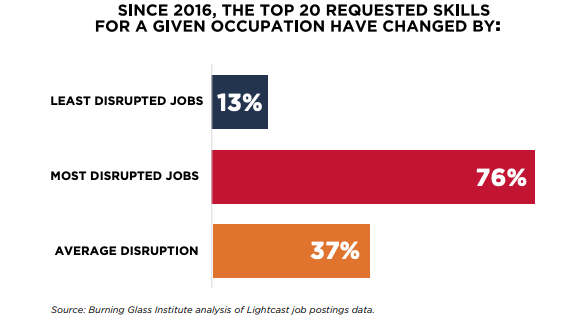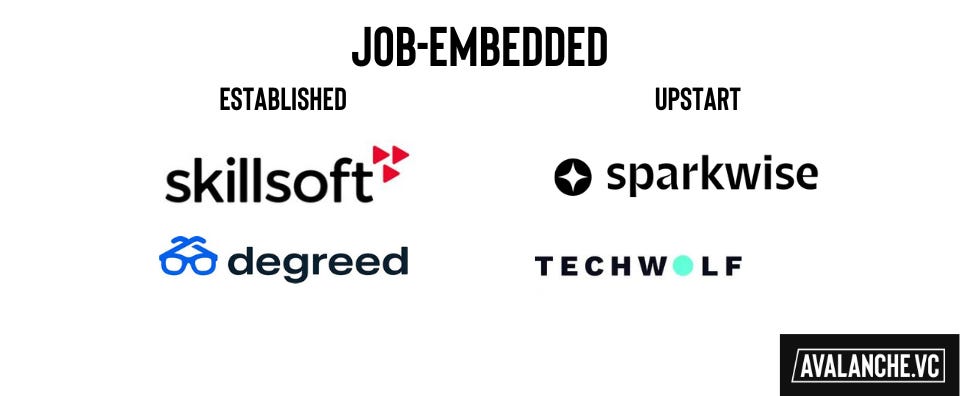The situation: On the brink
For years, the importance of building demonstrable skills has been growing. The research is clear: skills acquired through work experience increase lifetime earnings. Yet, a massive shift in how learners, educators, and employers think about skills is beginning.
Three subtrends set the stage for a massive inflection point in how we think about skills:
First, the gap between the skills higher education produces and those valued in the labor market is at an all-time high.
In the United States, students spend hundreds of thousands of dollars in debt to invest in a college education. However, students are left alone to bridge degrees in traditional disciplines to practical roles in industry. For example, turning a degree in economics into a job in product management or a degree in English into a job in content marketing.
Almost half of all university graduates will end up in jobs that don’t require a university degree. This has been true for almost three decades, as the chart below shows.
The escalating cost of a college education has given this underemployment a new urgency. Recent political debates and a rising student debt crisis point to a broken system that is too expensive for what it produces and leaves the individual holding the bill.
Second, employers and project marketplaces are moving away from degrees and increasing to skills-based hiring.
Talent shortages and a growing acknowledgment that employers have been using a bachelor’s degree as a poor proxy for skills have led to companies dropping the college degree requirement in hiring. In the last two years, employers reduced degree requirements for 46% of middle-skill positions and 31% of high-skill positions, according to data from Lightcast. Governments are following the lead: Maryland announced earlier this year that it no longer requires four-year degrees for thousands of state jobs. Employers are now looking to non-college educators and skill providers for evidence of skills instead.
Third, people change jobs or careers more often.
The data show a generational increase in career switching: The median tenure for workers aged 25 to 34 is 3.2 years, while for employees aged 65 and over, it is 10.3 years. Workers in management, professional, and related occupations had the highest median tenure (5.5 years), and workers in service occupations had the lowest median tenure (3.2 years). Each job move will likely require new skills, increasing the demand for upskilling and reskilling.
Why is now an inflection point for skills?
The inflection is driven by rapid advances in tech-enabled productivity, demographic change, and higher interest rates on the labor market, ’ increasingly seeking autonomy and flexibility in work life.
The half-life of technical skills is shortening. Strong foundational skills are paramount.
Foundational skills such as the three Rs (reading, writing, arithmetic) and four Cs (collaboration, creativity, critical thinking, and communication) have long been considered the minimum base for any successful adult in society. These skills are evergreen and drive workplace performance. However, in today’s workplace, foundational skills are not enough. As the rate of technological innovation grows exponentially, technical skills that jobs require will have a shorter shelf life. Mastery requires constant learning as new tools become available in knowledge and information work. The imperative to constantly upgrade one’s skills to be considered a high-skill worker will lead to an increased demand for upskilling products and services.
Advances in artificial intelligence put pressure on the human workforce to differentiate its skills.
Each iteration of GPT has gotten smarter and smarter, and an increasing number of lower-skilled human activities can now be substituted with AI. This ratchets up the need for workers to learn skills that involve the use and control of AI-enabled technology and that are unlikely to be automated away.
The demographic pyramid leads to a shrinking labor force in the Western world
Finding qualified labor across industries is challenging. Teaching and nursing are in high demand as the labor force ages, and the number of retirees increases. Schools and hospital staff are now heavily recruiting foreign labor from the Philippines and other countries with an educated workforce. A similar dynamic is shaping up in skilled trades like plumbing and construction. Workers are retiring, and there are not enough people to replace them.
Higher interest rates are driving labor market changes.
As interest rates have risen, jobs in the knowledge economy are becoming scarcer. Employee engagement is at an all-time low. Employees have reflected that learning is one of their main priorities in selecting a job. As the costs of acquiring labor have increased, employers have spent more to train and develop the workforce they already have. As a recession looms, companies will cut programs lacking effectiveness and concrete outcomes. While the ‘day in the life’ of the big tech employee videos were cute, they won’t stand the test of time when results matter.
Everyone will need to be or think like an entrepreneur as remote work increases.
In the Internet economy, teams can be globally distributed, and individuals can work from anywhere. Access to a global, distributed remote workforce allows employers to demand “just-in-time” skillsets. While remote work doesn’t make sense in every context, it is certainly a significant driver of the demand for concrete skills. The demand for output-based and the rise of freelancers, creators, and microbusinesses is interconnected, with skills being the connective tissue. Demand for higher productivity will drive the commodification skill assessment, verification, and onboarding of remote talent.
What projects and trends are capitalizing on transforming skills?
Learning will be the only constant throughout a career. Success in the modern workforce is learning experiences to build skills, and the best way to build skills is to do real-world projects.
Below is a sampling of organizations and companies pushing the boundaries. Some of these are established players with mature businesses and tested business models. Others are early upstarts with a vision for a new way of working. Many of these new models are backed by Avalanche VC.
Bootcamps: Effective approach to developing concrete skills in a short period.
Today, many online boot camps for tech-industry skills are marketed to students. These have demonstrated effectiveness and are linked to employment.
Job-Embedded: Learning skills on the job is critical.
Research shows that the most effective skill training happens on the job. The effectiveness and availability of employers' programs are critical. Emerging new models bring down costs and clarify outcomes.
Workforce Development: Skills for the trades need a tailored approach
Trades like construction, plumbing, and electrical work require their forms of training and quality assurance. Some solutions train people in skills that can be used in their local service marketplace. Others are social networks built for people in the construction industry. Others resemble a vertical labor marketplace.
Project-based training, e.g., apprenticeships
New programs have emerged that allow students and career changers to complete project-based work as proof that they will succeed on the job. Leading examples in this category include career apprenticeship programs and solutions bridging the gap between learning and experience, e.g., providers of shadowing and internship opportunities and opportunities to complete bite-sized virtual work experience programs micro-projects that give students a career advantage.
Credentials & Skill-Based Hiring: Assessing skills over degrees
Companies (and even state governments) are dropping college degree requirements. Opportunity at Work has led this movement. They have a talent-matching platform where trained professionals who are "Skilled Through Alternative Routes" (STARs) rather than a bachelor’s degree can find jobs. As a higher education degree is no longer enough to qualify for a job, new proxies have emerged for hireability. Full-stack solutions have emerged for people to demonstrate skills and be linked directly to hiring managers. Technical interviews and skill assessment platforms can improve candidate experience and ease hiring.
Micro and Meta Skills: Learning using video
These are short and can be consumed all at once. They often use video or interactive media. They may have a library of content on a big platform.
The essential meta-skill of our time is learning how to learn. An ‘entrepreneurial mindset' is an example of that skill. In practice, this means taking the initiative, seizing opportunities, being resilient, and having the drive to succeed. In our competitive, global world, this meta-skill correlates to success in other skills. Luckily, a few organizations help people foster this mode of thinking.
What makes skill-building businesses tricky?
The business model for skill-building has challenges
The industry is challenged on all fronts by high sales and customer acquisition costs, low willingness to pay, and a high premium on proof of efficacy and return on investment.
B2B business models often need to sell into the Human Resources or People Operations function. The learning and development function often lacks resources as the team is not directly tied to revenue. If the ROI on learning is low or unprovable, operational executives are less likely to want to devote resources toward upskilling.
B2C business models often struggle with high marketing costs to attract customers. There are several reasons for the high costs. One is that there is a limited barrier to entry, so there are many competitors. It's hard to differentiate a brand, and the products are highly similar. Additionally, most buyers are likely cash-strapped as they try to elevate their income. The businesses resemble schools that often have negative economies of scale. Each extra enrollee is less able to pay and less an immediate fit for the curriculum. The market for the target student is inherently limited and should relate to the job market.
There is no skill standardization.
There is a general lack of agreement on skill standards, exceptionally soft skills (see this mapping from the Harvard SEL project). There are over a million credentials in the US, and it’s difficult for learners to determine which will truly matter for their skill sets and career outcomes. While every company feels compelled to differentiate itself by developing unique skill taxonomies, the industry needs a common standard to enable “interoperability” and advance.
Conclusion:
Skills have never been more critical, but upskilling is as confusing and convoluted as ever. The business models are complex, as any business that wants to scale must demonstrate a durable competitive advance on distribution and costs. Yet there is opportunity in the chaos.
As machine learning progresses, human learning must keep up. Companies need to upskill their employee base to compete in the global economy. Software companies need to build learning mechanisms into their products. These will have a learning flywheel that updates their users with product improvements.
The need for upskilling is real. There are many emerging solutions but not one dominant player. Human learning will need to keep up with machines for society to prosper. The opportunity is everywhere — the question is, who will seize and scale it?
Disclosure: Avalanche VC is an investor in Sparkwise, NextGenHQ, Upright Education, Kurios, Tribute, and Hammr.
Further reading:
The Transformational Opportunity of AI on ICT Jobs Report. This is a 197-page treatise summarized by the finding that 92 percent of jobs analyzed are expected to undergo either high or moderate transformation due to advancements in AI.
If you want to grow in your career (and lifetime earnings), you need to focus on doing this
The Emerging Degree Reset and Skill Disruption Report from Burning Glass

















Very great article, more young people need to read this.
Really interesting article. Would love to see how this breaks out for employees with diverse learning profiles. It seems that most studies are conducted with neurotypical folks in mind. Where do people with learning disabilities, ADHD, ASD, and executive functioning delays fit into this? Potentially brilliant individuals with skills may not fit into the various skill acquisition programs in a traditional way--so are they put in a position to be trained and if so, how are they supported during the experience?